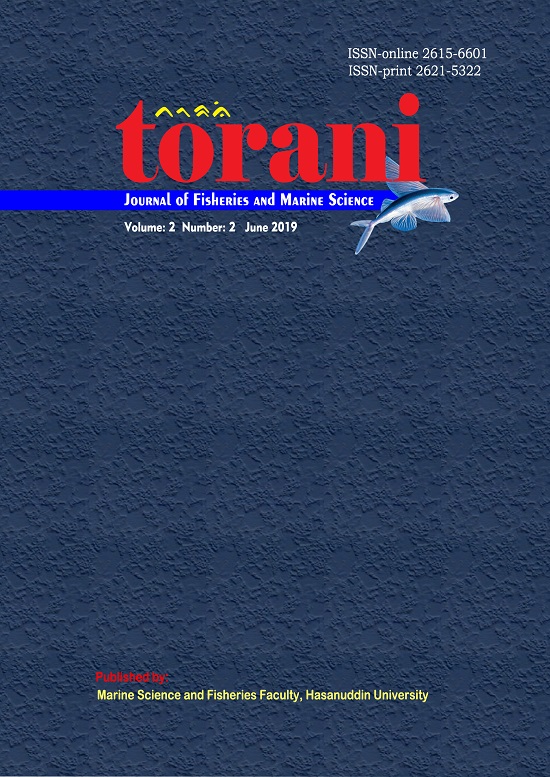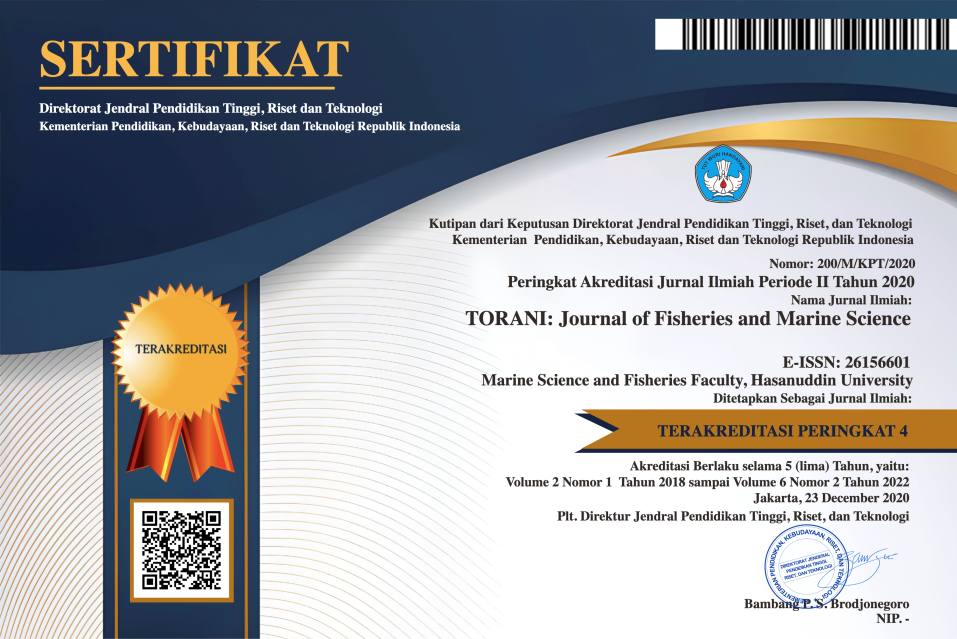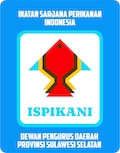The Ability of biofilter sponge demospongiae class with various forms of growth towards the turbidity and total suspended solid
DOI:
https://doi.org/10.35911/torani.v2i2.7058Abstract
The sponge is an invertebrate animal from phylum porifera that lives permanently and filters out what is in the water column. The sponge has various forms of growth, including massive, branching, and submissive. Each form of growth is indicated to have different filtering abilities, so this research needs to be done. This study aims to determine whether the ability to filter (biofilter) Turbidity and Total Suspended Solid sponge depends on the form of growth (Massive, Submassive, and Branching). This research was conducted from September to October 2016. Taking sponges in the waters of Barranglompo Island, testing was carried out at the Hatchery Marine Station at Hasanuddin University, Barranglompo Island and measurements of water quality parameters were carried out at the Chemical Oceanography Laboratory, Department of Marine Sciences, Faculty of Marine and Fisheries, Hasanuddin University. The acclimatization process needs to be done to adapt the sponge before being given treatment. Each aquarium is filled with seawater that has been mixed with sediments as much as 0.17 mg/l. Then each form of sponge growth is put into an aquarium with the same body volume of 500 cm3 and sees the ability to filter it for 10 hours and 24 hours. After that, water samples were taken at each aquarium to measure turbidity parameters, Total Suspended Solid, and Total Organic Materials. The results showed that at 10 hours and 24 hours the sponge with submassive growth forms filtered more particles in the water column than massive and branching growth forms, while sponge with branching growth forms run into stress and death after filtering for 24 hours.Keywords: growth pattern, biofilter, sediment, sponge.Downloads
References
Amir, I., A. Budiyanto, 1996. Mengenal Spons Laut (Demospongiae) Secara Umum. Oseana 1996; 21 (2): 15 – 31.
Bakus, G., 1968. Sedimentation and benthic invertebrates of Fanning Island, central Pacific. Mar. Geol. 6, 45–51.
Bell, JJ., DK, Barnes., 2000a. A sponge diversity centre within a marine ‘island’. Anonymous Island, Ocean and Deep-Sea Biology. Springer, pp. 55–64.
Bell, J., McGrath E., Biggerstaff, A., Bates, T., Bennett, H., Marlow, J., Shaffer, M., 2015. Sediment Impact on Marine Sponges. Marine Pollution Bulletin 94
Bowerbank, J.S., 1875. Contributions to a general history of the Spongiadae. Proc. Zool. Soc. London, 1875: 281 - 296.
Fitrianto, N. E. 2009. Laju Pertumbuhan dan Sintasan Spons Aaptos aaptos Di Kolam Buatan Terkontrol. Program Studi Ilmu dan Teknologi Kelautan, FPIK. Institut Pertanian Bogor
Haris A, 2013. Sponge: Biologi dan Ekologi. Fakultas Ilmu Kelautan dan Perikanan – Universitas Hasanuddin, Makassar
Ilan, M., A. Abelson, 1995. The life of a sponge in a sandy lagoon. Biol. Bull. 189, 363–369.
Parker, G.H., 1910. The Reactions of Sponges with a Consideration of The Origin of The Nervous System. Professor of Zoölogy in Harvard University.
Riisgard, H.U., S., Thomassen, H., Jakobsen, Weeks, J.M., Larsen, P.S., 1993. Suspension feeding in marine sponges Halichondria panicea and Haliclona urceolus: effects of temperature on filtration rate and energy cost of pumping. Marine Ecol. Progr. Ser. 96, 177–188.
Subagio, B., I. dan Aunurohim. 2013. Struktur Komunitas Spons Laut (Porifera) di Pantai Pasir Putih, Situbondo. Biologi. Fakultas Matematika dan Ilmu Pengetahuan Alam, Institut Teknologi Sepuluh Nopember. Surabaya
Suparno, 2005. Kajian Bioaktif Spons Laut (Forifera: Demospongiae) Suatu Peluang Alternatif Pemanfaatan Ekosistem Karang Indonesia Dalam Di Bidang Farmasi. Makalah Pribadi Falsafah Sains (PPs 7002) : IPB
Tarigan, M.S dan Edward. 2003. Kandungan Total Zat Padat Tersuspensi (Total Suspended Solid) Di Perairan Raha, Sulawesi Tenggara. Bidang Dinamika Laut, Pusat Penelitian Oseanografi. Jakarta.
Van Soest, R.W.M., 2009. New sciophilous sponges from the Caribbean (Porifera: Demospongiae). University of Amsterdam
Widigdo, B. 2001. Manajemen Sumberdaya Perairan. Bahan Kuliah. Fakultas Perikanan dan Ilmu Kelautan. Institut Pertanian Bogor.



















